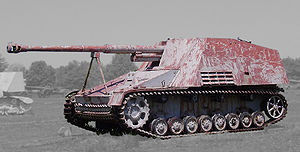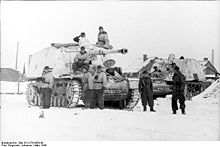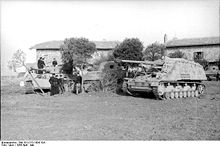- Nashorn
-
SdKfz 164 Nashorn 
Type Tank destroyer Place of origin  Nazi Germany
Nazi GermanyProduction history Number built 473 Specifications Weight 24 tonnes (52,910 lbs) Length 8.44 m (27 ft 8 in) with gun Width 2.95 m (9 ft 8 in) Height 2.65 m (8 ft 8 in) Crew 4 or 5 Armor hull: 20-30 mm (.78-1.18 in)
superstructure: 10 mm (.39 in)Main
armament8.8 cm (3.46 in) Pak 43/1 Secondary
armament7.92 mm MG (carried inside) Engine Maybach 11.9 litre V-12 gasoline
300 PS (296 hp, 221 kW)Power/weight 12.5 PS/tonne Suspension leaf spring Operational
range235 km (146 mi) Speed 42 km/h (26.71 mph) Nashorn (German "rhinoceros", pronounced Nahz-horn, not Nash-orn), initially known as Hornisse (German "hornet"), was a German tank destroyer of World War II. It was developed as an interim solution in 1942 and was armed with the outstanding Pak 43 anti-tank gun. Though only lightly armoured and with a high profile, it stayed in service until the end of the war and proved to be a quite successful tank destroyer.
Contents
Development
 Nashorn tank destroyers on the Eastern Front, 1944
Nashorn tank destroyers on the Eastern Front, 1944
After the first German experiences with the newer Soviet tanks like the T-34 or the Kliment Voroshilov tank during Operation Barbarossa, the need for a Panzerjäger capable of destroying these heavily armoured tanks became clear.
In February 1942, the Alkett (Altmärkische Kettenwerke GmbH) arms firm of Berlin designed a tank destroyer using their recently developed Geschützwagen III/IV which as its name indicated used components of both the Panzer III and Panzer IV tank. The 8,8 cm Panzerabwehrkanone 43/1 L/71 (or shortly Pak 43/1) , a long-barreled anti-tank gun, was mounted on the rear of the chassis complete with its gun shield and an open-topped superstructure was built up around the gun to give the crew some protection. The gun had the same traverse and elevation as if it had been on its carriage: 15° to either side and between -5° to +15° elevation. To accommodate the long and heavy gun, the hull had to be lengthened and the engine moved from the rear to the centre of the chassis. Weight considerations meant that the amount of armour which could be used for the fighting compartment was limited, the crew were only protected from blast and small arms.
This model was presented for approval to Adolf Hitler in October 1942 and entered production in early 1943. It had numerous official designations, such as 8,8 cm Pak 43 (L/71) auf Fahrgestell Panzerkampfwagen III/IV (Sf) or 8,8cm Pak43 (L/71) auf Geschützwagen III/IV (Sd. Kfz. 164), though it was also known as the Panzerjäger Hornisse (in English "armor hunter hornet")
During the first half of 1943, a new model of the Hornisse was introduced into production. This model altered the driver's front armour plate, along with other petty differences. The difference between this model and its predecessor, the few early production vehicles, were almost indistinguishable. It was renamed Nashorn by Hitler in 1944.
Total production of the Hornisse/Nashorn amounted to some 494 vehicles, of which most were built in 1943. Since January 1944 Germany favored the production of the newer tank destroyer, the Jagdpanzer IV, which had a much thicker armor (60 mm frontal plate) if a less powerful 7.5 cm gun. Production of Nashorn continued, though at a slow pace, into 1945.
There are two Nashorns on display in military museums: at the United States Army Ordnance Museum and at the Kubinka Tank Museum.
Combat service
The Hornisse/Nashorn was issued to the heavy antitank battalions (schwere Panzerjäger-Abteilungen), with which six would eventually be equipped: schwere Panzerjäger Abteilung 560, 655, 525, 93, 519 and 88. Each battalion was equipped with 45 Nashorns.
Nashorn's gun was a variant of Pak 43, one of the most effective anti-tank guns deployed during the war and closely related to guns used later for Ferdinand/Elefant, Tiger II, and Jagdpanther. Its tungsten carbide–cored sub-calibre round, Pzgr. 40/43, was capable of penetrating 190 mm of rolled steel armour at a 30° angle of impact at a distance of 1,000 m. The gun's tremendous performance enabled Nashorn to penetrate the front plating of any Allied armoured vehicle and to engage enemy while staying out of range themselves.
The Hornisse/Nashorn made its debut during the Battle of Kursk, where they performed well. The ability to engage the enemy at long distances negated the disadvantages of light armour and a high profile and revealed the weapon was suited to the open, flat landscape of much of Russia.
Armor
Sd.Kfz. 164 Nashorn Thickness/slope Front Side Rear Top/Bottom Turret/Gun Shield 10–15 mm (0.39–0.59 in)/30°[1] open Superstructure 15 mm (0.59 in)/70° 10 mm (0.39 in)/15° 10 mm (0.39 in)/10° 10 mm (0.39 in) Hull 30 mm (1.2 in)/12° 20 mm (0.79 in)/0° 20 mm (0.79 in)/21° 15 mm (0.59 in) Technical data
- Manufacturer: Deutsche-Eisenwerke AG, in Teplitz-Schönau
- Crew: 4 or 5
- Combat weight: 24 metric tons
- Dimensions
- Length (with gun): 8.44 m
- Length (without gun): 7.26 m
- Width: 2.95 m, 3.176 m with 'Ostketten' tracks
- Height: 2.65 m
- Ground clearance: 0.4 m
- Road speed: 42 km/h
- Road range: 235 km
- Tracks: 61/400/120 kg
- Type: single pin
- Width: 400 mm
- Ground contact length: 3.80 m
- Shoes(links)/track: 104
- Ground pressure: 0.85 kg/cm²
- Suspension: leaf spring
- Shock absorbers: no
- Vertical obstacle: 0.6 m
- Trench: 2.3 m
- Fording: 0.8 m
- Engine: Maybach HL 120 TRM Ausf. A
- Type: V-12 60 deg
- Horsepower: 300 PS @ 3000 rpm
- Displacement: 11,867 l
- Comression ratio: 6.2-6.5:1
- Fuel: gasoline
- Fuel consumption (road): 2 l/km
- Fuel capacity: 470 l (two fuel tanks)
- Transmission: ZF (Zahnradfabrik Friedrichshafen AG) SSG 77 Aphon
- Type: synchromesh manual
- Gears: 6/1
- Steering: Daimler-Benz/Wilson clutch/brake
- Clutch: Fichtel & Sachs La 120 HDA dry, triple disc
- Armament
- Main gun: 88 mm Pak 43/1
- Type: Anti-tank gun
- Caliber: 88 mm
- Barrel length: 71 calibers
- Breech: semiautomatic, horizontal sliding block
- Traverse: manual, +/-15°
- Elevation: manual, +20/-5°
- Rounds carried: 24 to 40
- one 7.92 x 57 mm MG-34 or MG-42 machine-gun carried inside the vehicle
- appr. 600 rounds
- Primary gun sight: Sfl. Z. F. 1a (Selbstfahrlafetten-Zielfernrohr)
- Magnification: 5x
- Field of view: 8°
- Indirect fire sight: Aushilfsrichtmittel 38
- Magnification: 3x
- Field of view: 10°
- Radio: FuG Spr. f
Notes
- ^ 15mm after May 1943
External links
- Achtung Panzer!-Nashorn Page
- WWII Vehicles
- Hornisse manual
- Armour penetration table of 8.8 cm Pak 43
- Surviving Panzer IV variants - A PDF file presenting the Panzer IV variants (Jagdpanzer IV, Hummel, Nashorn, Brummbär, StuG IV, Flakpanzer tanks and prototypes based on Pz IV) still existing in the world
Tanks Panzer I · Panzer II · Panzer III · Panzer IV · Panther · Tiger I · Tiger II · Panzer 35(t) · Panzer 38(t)Self-propelled artillery Assault guns Tank destroyers Panzerjäger I · Marder I , II , III · RSO/PaK 40 · Nashorn · Elefant · Jagdpanzer IV · Hetzer · Jagdpanther · JagdtigerHalf-tracks Armored cars Self-propelled anti-aircraft guns Prototypes Panzer VIII Maus · E- series · Panther II · Heuschrecke 10 · Neubaufahrzeug · Sturer Emil · 10.5 cm K (gp.Sfl.) · Pz.Sfl. II · Flakpanzer Coelian · KugelpanzerProposed designs Categories:- World War II tank destroyers of Germany
Wikimedia Foundation. 2010.

